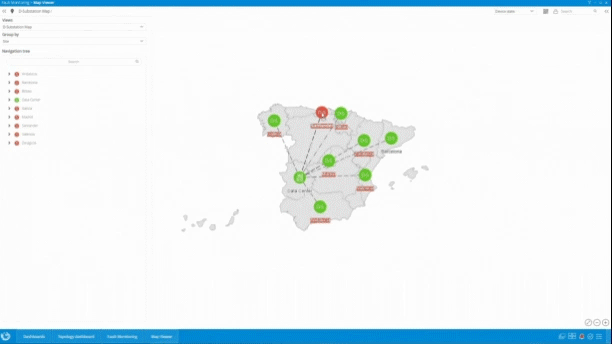18 Nov 2022
Emerging technologies such as the Internet of Things (IoT), cloud computing, and network virtualization coupled with consistent exponential technological advancements have led to the creation of more complex and dynamic networks. In addition, modern enterprises have numerous monitored devices and multiple branches distributed in wide geographical areas that add to the complexity and requirement of network mapping tools.
It is crucial to understand the structure of such intricate network connections for better asset management and delivery of critical services. While most sophisticated asset management tools can help with inventories, enhanced visibility into the network is crucial as it offers an understanding of the devices and how they are interconnected.
Network mapping delivers enhanced network-wide visibility suitable for modern networks. Using advanced tools, network administrators (NAs) employed by businesses can see the devices on the network, detect faults, and gain real-time data updates among other advantages. Such information is useful for the optimization of the network’s performance.
Read on for a useful in-depth guide on networking mapping!
An Introduction to Network Mapping
Network mapping is the process of identifying all the assets linked to a network, their interconnections, and how network traffic flows through them. The term is used as a blanket description of integrated tasks including creating network diagrams, detecting topologies, and taking asset inventories.
The most popular use of network maps is network maintenance. Common maintenance practices include network visualization, monitoring, and fault detection among others.
Although network mapping can be done manually, the increased complexity and dynamic nature of modern networks call for more advanced mapping provided by automatic tools. These tools also offer real-time updates, which are critical for network security and optimization.
Network mapping systems are not all built the same. Some can only show you open ports and shares while others go as far as collecting and giving you the IP addresses of the linked devices and their performance statistics. The choice of tools to use depends on a client’s unique requirements.
Visualization: Network Assets
Network assets are at the center of all network mapping efforts. Assets refer to any physical devices, fragments of larger environments, or system events that can be classified as endpoints on the network map. They are typically represented by icons, logos, or other distinctive visual elements.
The assets are typically categorized based on their types, families, subnets, areas etc. Clustering the assets helps to either give more context or place them in a hierarchy.
Each asset has a set of factors, such as name, IP address, size, and location that define it and distinguish it from the rest. The factors are displayed depending on their significance and the available space. Details like connectivity and severity are vital and should always be presented to users.
How Network Mapping Works
Manual mapping involves using commands such as ping and traceroute on the command line to discover components on the network. Conversely, automatic mapping can be done using Network mapping systems.
Using Network Mapping Tools
Mapping the network manually using only commands is inefficient. Network mapping tools streamline the process. The introduction of network mapping systems also brought about unprecedented levels of visibility that offer significant advantages.
Mapping tools, such as SGRwin, can perform mapping automatically, monitor the network, and give real-time updates on changes made on the network. Network mapping systems can either exist on their own or as part of a larger network management system. Either way, most of them have either of the working mechanisms explained below.
Active probing
Active probing is the most common network mapping method. In this method, the system sends probe packets to different nodes on the network. These probe packets collect technical information, such as IP addresses, before making their way back to the system.
Route analytics
The route analytics approach listens to layer 3 protocol exchanges between routers, retrieves routing protocol data, and then uses the data to develop a network map.
SNMP-based approaches
The SNMP-based approach creates a network map using data fetched from the router and the switch MIBs.
Advantages of Using Network Mapping Tools
The enhanced visibility provided by networking mapping processes is useful for a myriad of critical network activities. Businesses that utilize an accurate tools often benefit from real-time network monitoring, easier fault detection and correction, better network security, and more efficient maintenance activities.
- A broader perspective of the relationships between devices on your network, therefore simplifying and fastening network discovery, correlation and diagnosis. For instance, SGRwin automates the mapping process by enabling the auto-discovery of devices linked to your network.
- Real-time network monitoring: monitoring modules can be used to track real-time changes. These modules can fetch, analyse, and display live updates made on network data.
- Alarms and events categorization: Most sophisticated mapping tools can classify alarms and events on your network, facilitating troubleshooting actions by enabling you to prioritize network faults.
- Enhanced fault detection and correction: Error analysis is complicated in complex networks. Network mapping makes it easier by enabling administrators to fragment complex networks into portions that are easier to analyse and detect errors.
- Quick correlation. Network visualization and network mapping simplify correlation processes enabling to visualise cross connections and routes.
Fragmenting also enables network administrators to fetch information that is useful for root cause analysis. The end-to-end visibility allows NAs to visualize the network and identify problematic physical and virtual devices.
- Network security: Since organizations with complex networks often use these mapping tools to monitor their networks and receive updates on changes, they can often swiftly pinpoint threats in real time.
- Network maintenance: The results of network mapping are often reports and helpful visuals such as component performance statistics, inventory reports, network diagrams, and flowcharts. These reports are required for maintenance activities.
Map Your Network With SGRwin
SGRwin is an FCAPS-based network management solution that can provide an extensive view of any network, including its interfaces and assets. Clients can use the NMS to create custom networking maps. They can represent all elements on a single map or different maps with different views, depending on their objectives. Moreover, the solution enables users to categorise network elements for each area or user group.

In addition to topology maps, our high-performance system can also provide detailed inventory reports of the assets on a network to help businesses keep track.
Most network mapping tools provide device status information and send alarms to administrators when there is a problematic device or when it comes across threats on the network. Having statuses and alarms is vital since it helps administrators keep performance at optimal levels.
SGRwin does this and so much more. Our network management software can map the entire network and show you how components are connected and how they correlate. Such knowledge is critical when identifying problematic interfaces and devices on the network.

The following are the key advantages of the functionalities that our NMS offers:
- Enhanced visibility into how components are interconnected on your network. Our tool offers a better understanding of the relationships between devices on your network, making device discovery and diagnosis of problems easier.
- Multi-vendor support: When it comes to integration, SGRwin is king. The NMS supports all device types from third-party manufacturers.
- Up-to-date maps: The SGRwin system is designed to identify and provide real-time updates on any changes executed on the network. For instance, our system will give an update when a device is added or removed from your network.
- Other equally significant advantages are advanced inventory reports and enhanced end-to-end (E2E) service provisioning.
What are you waiting for? Get a quote today!
